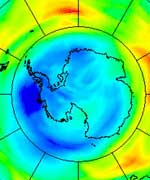
Image credit: ESA
The smudges of dark blue on this Envisat-derived ozone forecast trace the start of what has unfortunately become an annual event: the opening of the ozone hole above the South Pole.
“Ever since this phenomenon was first discovered in the mid-1980s, satellites have served as an important means of monitoring it,” explained Jos? Achache, ESA Director of Earth Observation Programmes. “ESA satellites have been routinely observing stratospheric ozone concentrations for the last decade.
“And because Envisat’s observations are assimilated into atmospheric models, they actually serve as the basis of an operational ozone forecasting service. These models predict the ozone hole is in the process of opening this week.”
Envisat data show 2004’s ozone hole is appearing about two weeks later than last year’s, but at a similar time period to the average during the last decade. The precise time and range of Antarctic ozone hole occurrences are determined by regional meteorological variations.
The ozone hole typically persists until November or December, when increasing regional temperatures cause the winds surrounding the South Pole to weaken, and ozone-poor air inside the vortex is mixed with ozone-rich air outside it.
The ozone hole of 2002 was an exception to this general pattern, when a late September slowdown of the polar vortex caused the ozone hole to split in two and dissipate early. Envisat’s predecessor mission, ERS-2, monitored the process.
“Envisat carries an instrument called the Scanning Imaging Absorption Spectrometer for Atmospheric Cartography (SCIAMACHY), based on a previous instrument flown aboard ERS-2, called the Global Ozone Monitoring Experiment (GOME),” said Henk Eskes of the Royal Netherlands Meteorological Institute (KNMI). “The two instruments give us a combined data set that stretches over ten years, one that Envisat adds to every day with fresh observations.
“This data set presents a very good means of eventually identifying long-term trends in ozone. Whether or not the ozone layer is starting to recover is a hotly debated topic at the moment.”
The stratospheric ozone layer protects life on Earth from harmful ultraviolet (UV) radiation. The ozone thinning represented here is ultimately caused by the presence of man-made pollutants in the atmosphere such as chlorine, originating from man-made pollutants like chlorofluorocarbons (CFCs).
Now banned under the Montreal Protocol, CFCs were once widely used in aerosol cans and refrigerators. CFCs themselves are inert, but ultraviolet radiation high in the atmosphere breaks them down into their constituent parts, which can be highly reactive with ozone.
Just because they were banned does not mean these long-lived chemicals have vanished from the air, so scientists expect the annual South Polar ozone hole to continue to appear for many years to come.
During the southern hemisphere winter, the atmospheric mass above the Antarctic continent is kept cut off from exchanges with mid-latitude air by prevailing winds known as the polar vortex. This leads to very low temperatures, and in the cold and continuous darkness of this season, polar stratospheric clouds are formed that contain chlorine.
As the polar spring arrives, the combination of returning sunlight and the presence of polar stratospheric clouds leads to splitting of chlorine into highly ozone-reactive radicals that break ozone down into individual oxygen molecules. A single molecule of chlorine has the potential to break down thousands of molecules of ozone.
ESA’s ten-instrument Envisat spacecraft carries three instruments to measure the atmosphere; the results here come from SCIAMACHY, which provides global coverage of the distribution of ozone and other trace gases, as well as aerosols and clouds.
KNMI processes SCIAMACHY data in near-real time as the basis of an operational ozone forecasting service. This is part of a suite of atmospheric information services provided by a project called TEMIS (Tropospheric Emission Monitoring Internet Service) that also includes UV radiation monitoring and forecasting.
TEMIS is backed by ESA as part of the Agency’s Data User Programme, intended to establish viable Earth Observation-based services for communities of users.
The TEMIS atmospheric ozone forecast seen here has atmospheric ozone measured in Dobson Units (DUs), which stands for the total thickness of ozone in a given vertical column if it were concentrated into a single slab at standard temperature and atmospheric pressure ? 400 DUs is equivalent to a thickness of four millimetres, for example.
Envisat results to be revealed
Launched in March 2002, ESA’s Envisat satellite is an extremely powerful means of monitoring the state of our world and the impact of human activities upon it. Envisat carries ten sophisticated optical and radar instruments to observe and monitor the Earth’s atmosphere, land, oceans and ice caps, maintaining continuity with the Agency’s ERS missions started in 1991.
After two and a half years in orbit, more than 700 scientists from 50 countries are about to meet at a special symposium in Salzburg in Austria to review and discuss early results from the satellites, and present their own research activities based on Envisat data.
Starting next Monday, the Envisat Symposium will address almost all fields of Earth science, including atmospheric chemistry, coastal studies, radar and interferometry, winds and waves, vegetation and agriculture, landslides, natural risks, air pollution, ocean colour, oil spills and ice.
There are over 650 being presented at the Symposium, selected by peer review. Presentations will include results on the Prestige oil spill, last year’s forest fires in Portugal, the Elbe flooding in 2002, the evolution of the Antarctic ozone hole, the Bam earthquake and pollution in Europe.
Numerous demonstrations are planned during the week in the ESA Exhibit area. An industrial consortium exhibit on the joint ESA-European Commission Global Monitoring for Environment and Security (GMES) initiative is also planned.
Original Source: ESA News Release


